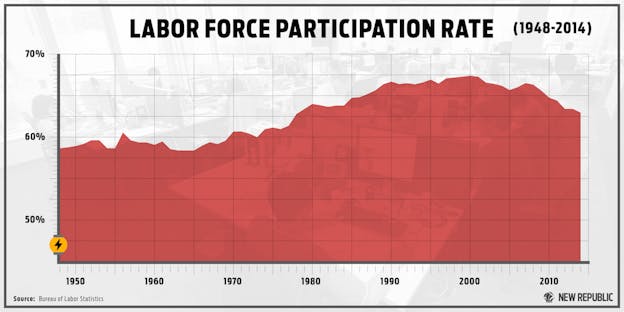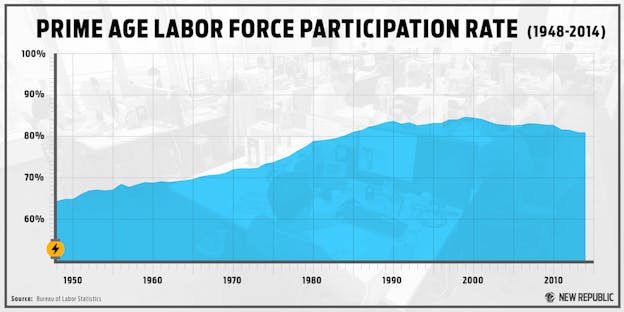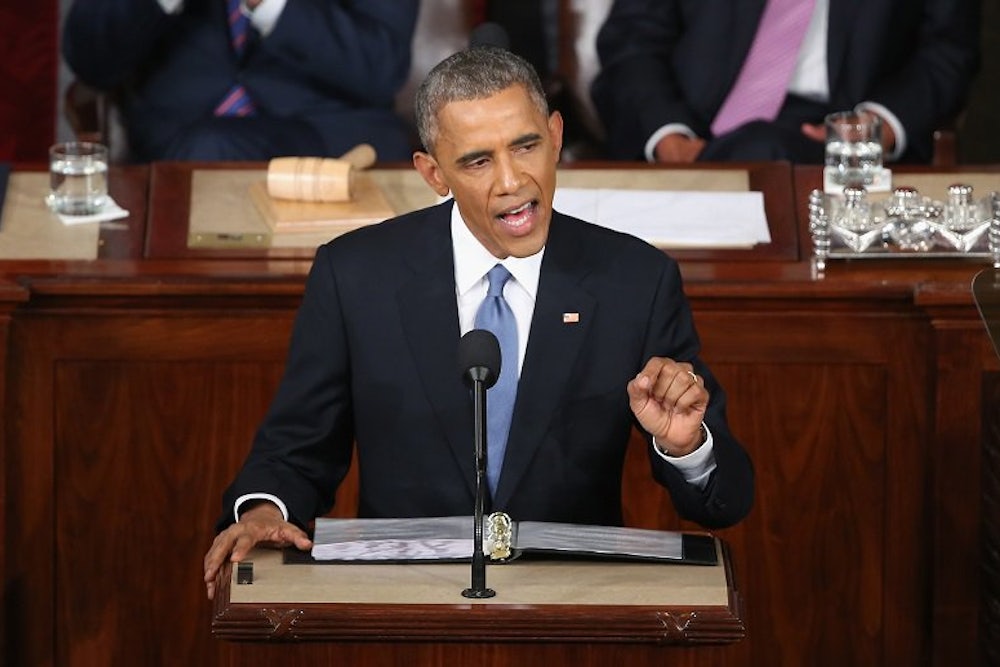In Tuesday night’s State of the Union address, President Barack Obama touted the many ways that the economy has improved over the past year: lower unemployment, stronger economic growth, and lower gas prices. Wages are still stagnant but these improvements, particularly the lower gas prices, are boosting the president’s approval rating toward 50.
Republicans still aren’t willing to admit that the economy has taken significant steps over the past 12 months, but their economic attacks on the president have shifted. No longer do they cite the unemployment rate as an indicator of the failure of Obamanomics. The new statistic du jour is the labor force participation rate (LFPR). Republicans aren’t wrong to be concerned about this number. But the reason it’s trending downward predates Obama—and the party’s newfound focus on this stat is indicative of the political problem that an improving economy poses for the GOP.
The labor force participation rate is the number of people who are either employed or actively looking for work as a share of the population that could be working. Under Obama, the rate has declined from 65.7 percent in January 2009 to its current rate of 62.7 percent, its lowest point since the late 1970s. (It peaked at 67.3 percent in 2000.)

There are a few reasons why the LFPR has declined. First, the country is aging as baby boomers retire. An older country means a lower percent of the population will be in the labor force. This is a structural reason for the LFPR’s recent decline—it was going to happen regardless of the underlying economic conditions. That’s why many economists forecasted that the rate would slowly fall over time.
But then the financial crisis hit, sending the participation rate shooting down. Given the bleak economic conditions, many workers dropped out of the labor force altogether. These discouraged men and women would like a job, but think their prospects are too dim to even spend time looking for work. Younger Americans stayed in school, looking to bolster their resumes instead of entering the job market. The number of people who collect Social Security Disability Insurance has also risen substantially. Initially, at least, these were cyclical reasons for the LFPR’s decline—they were caused by the recession and were expected to turn around as the economy improved. Discouraged workers, for instance, were expected to reenter the labor market once the recovery took hold and their jobs prospects improved.
A better way to judge the labor market is the prime-age (aged 25-54) labor force participation rate. This will eliminate the effects of students staying in school longer and baby boomers retiring, since it focuses just on people in their prime working years. At 80.8 percent, the prime-age LFPR is near its lowest point since the early 1980s. As you can see from this graph, this is a long-term trend in the American economy that predates Obama. The recession may have slightly accelerated, but it certainly didn’t start it.

This tells us that there is some other structural reason—one not related to the underlying economic conditions—that has caused working age Americans to drop out of the labor force over the past few decades. In December, the New York Times investigated this question by looking at a similar statistic, the employment-to-population ratio, which you will also now hear Republicans cite as a reason that Obamanomics has failed. The Times reports, one on men and one on women, didn’t come to any definitive answer, but it is clear that part of the reason Americans are exiting the workforce is that wages are too low for them to accept the jobs.
So are Republicans right to blame the president for the decline in the labor force participation rate? Not really, because the trend existed well before Obama took office.
But it definitely worsened under him. The recession officially ended in 2009, and the participation rate still has not recovered. There was good news in 2014 on that front: the rate finally stabilized. Since retiring baby boomers are pushing the LFPR down, the stabilization of the rate indicates that the improving economy is causing some workers to reenter the labor market. But it took a long time to reach this point and there's no sign that the rate will actually begin rising either. We’re rapidly reaching the point where many of those cyclical reasons outlined above are becoming structural ones—that Americans who dropped out of the labor market because of the economy won’t reenter it even as the economy improves. The evidence shows, for instance, that people collecting Social Security Disability Insurance aren’t coming back to the labor market. As the participation rate stays flat, it’s becoming clear that the same goes for the millions of Americans who exited the labor force, too discouraged to seek work. Many of them have seen their skills eroded and are no longer appealing candidates for any job. The permanent loss of these workers from the labor force is one of the greatest long-term costs of the Great Recession.
If Obama's economic agenda was ineffective at spurring the recovery, then yes, he should be blamed for the loss of these workers—and that’s what Republicans are trying to argue. But Obama’s economic record is quite strong, given the political opposition he faced from the GOP. Economists widely agree that the stimulus helped the economy, and Republicans hindered the recovery by using the debt ceiling as a hostage-taking device and extracting policy concessions—most notably, the sequester—that have hurt growth. (Obama erred by even negotiating with the GOP. He learned that lesson the hard way.)
It's easy to point to an unemployment rate at 7 or 8 percent as proof that the president’s policies have failed to revive the economy. Republicans took that approach for the first six years of Obama’s presidency. As a political strategy, it made sense, even if the Great Recession—which pre-dated Obama's election—was truly to blame. Republicans can no longer make that argument, as the unemployment rate sits at 5.6 percent now, so they've turned to the labor force participation rate as proof that Obamanomics has failed.
Republicans were right that a 7 percent unemployment rate was unacceptable. They’re also right that a declining labor force participation rate is unacceptable. But once again, they’re wrong to lay the blame on Obama—and it's going to be a lot harder to convince Americans to worry about a declining LFPR than it was the rising unemployment rate. Americans are beginning to feel optimistic about the economy, and it'll take more than an acronym and finger-pointing to reverse that trend.
